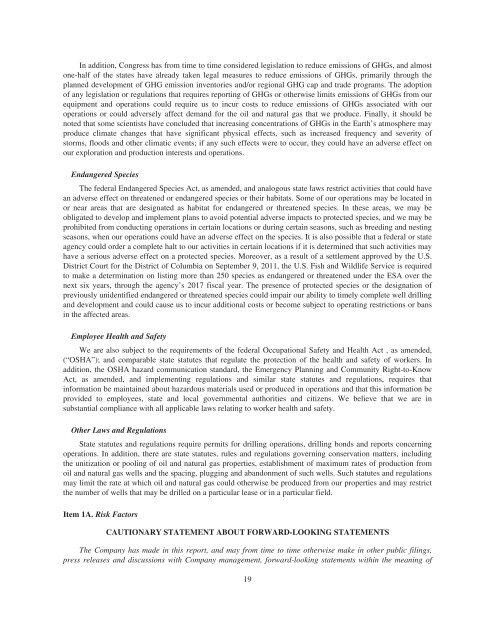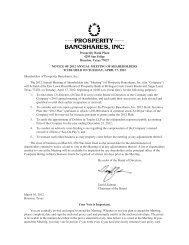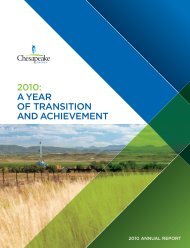goodrich petroleum corporation - RR DONNELLEY FINANCIAL
goodrich petroleum corporation - RR DONNELLEY FINANCIAL
goodrich petroleum corporation - RR DONNELLEY FINANCIAL
Create successful ePaper yourself
Turn your PDF publications into a flip-book with our unique Google optimized e-Paper software.
In addition, Congress has from time to time considered legislation to reduce emissions of GHGs, and almost<br />
one-half of the states have already taken legal measures to reduce emissions of GHGs, primarily through the<br />
planned development of GHG emission inventories and/or regional GHG cap and trade programs. The adoption<br />
of any legislation or regulations that requires reporting of GHGs or otherwise limits emissions of GHGs from our<br />
equipment and operations could require us to incur costs to reduce emissions of GHGs associated with our<br />
operations or could adversely affect demand for the oil and natural gas that we produce. Finally, it should be<br />
noted that some scientists have concluded that increasing concentrations of GHGs in the Earth’s atmosphere may<br />
produce climate changes that have significant physical effects, such as increased frequency and severity of<br />
storms, floods and other climatic events; if any such effects were to occur, they could have an adverse effect on<br />
our exploration and production interests and operations.<br />
Endangered Species<br />
The federal Endangered Species Act, as amended, and analogous state laws restrict activities that could have<br />
an adverse effect on threatened or endangered species or their habitats. Some of our operations may be located in<br />
or near areas that are designated as habitat for endangered or threatened species. In these areas, we may be<br />
obligated to develop and implement plans to avoid potential adverse impacts to protected species, and we may be<br />
prohibited from conducting operations in certain locations or during certain seasons, such as breeding and nesting<br />
seasons, when our operations could have an adverse effect on the species. It is also possible that a federal or state<br />
agency could order a complete halt to our activities in certain locations if it is determined that such activities may<br />
have a serious adverse effect on a protected species. Moreover, as a result of a settlement approved by the U.S.<br />
District Court for the District of Columbia on September 9, 2011, the U.S. Fish and Wildlife Service is required<br />
to make a determination on listing more than 250 species as endangered or threatened under the ESA over the<br />
next six years, through the agency’s 2017 fiscal year. The presence of protected species or the designation of<br />
previously unidentified endangered or threatened species could impair our ability to timely complete well drilling<br />
and development and could cause us to incur additional costs or become subject to operating restrictions or bans<br />
in the affected areas.<br />
Employee Health and Safety<br />
We are also subject to the requirements of the federal Occupational Safety and Health Act , as amended,<br />
(“OSHA”); and comparable state statutes that regulate the protection of the health and safety of workers. In<br />
addition, the OSHA hazard communication standard, the Emergency Planning and Community Right-to-Know<br />
Act, as amended, and implementing regulations and similar state statutes and regulations, requires that<br />
information be maintained about hazardous materials used or produced in operations and that this information be<br />
provided to employees, state and local governmental authorities and citizens. We believe that we are in<br />
substantial compliance with all applicable laws relating to worker health and safety.<br />
Other Laws and Regulations<br />
State statutes and regulations require permits for drilling operations, drilling bonds and reports concerning<br />
operations. In addition, there are state statutes, rules and regulations governing conservation matters, including<br />
the unitization or pooling of oil and natural gas properties, establishment of maximum rates of production from<br />
oil and natural gas wells and the spacing, plugging and abandonment of such wells. Such statutes and regulations<br />
may limit the rate at which oil and natural gas could otherwise be produced from our properties and may restrict<br />
the number of wells that may be drilled on a particular lease or in a particular field.<br />
Item 1A. Risk Factors<br />
CAUTIONARY STATEMENT ABOUT FORWARD-LOOKING STATEMENTS<br />
The Company has made in this report, and may from time to time otherwise make in other public filings,<br />
press releases and discussions with Company management, forward-looking statements within the meaning of<br />
19











